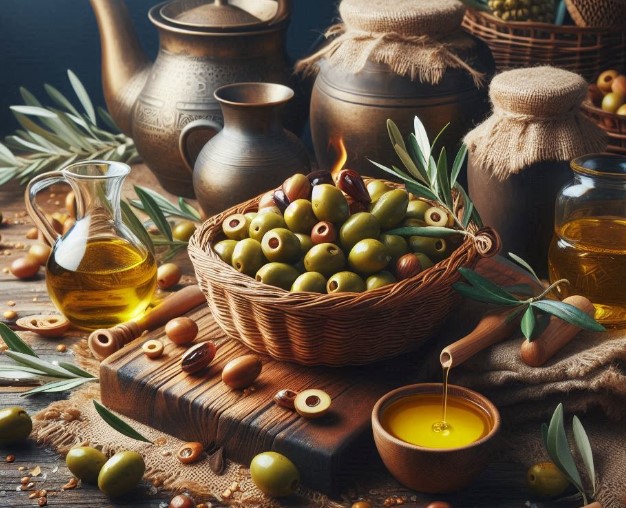If there is one product that embodies recent inflation, it is olive oil. Its price has risen significantly due to the impact of two poor harvest years—2022-2023 with a production of 665,000 tons and 2023-2024 with more than 852,000 tons—as well as periods of drought. However, with the introduction of the new “Green Gold” crop, effective from January for the 2024-2025 campaign, with a yield estimated at over 1.4 million tons, the price has reportedly fallen. This is supported by the April CPI data released on Wednesday, which showed a 2.2% increase. According to the National Institute of Statistics (INE), the price of olive oil fell 5.5% compared to March (last month it was already 5.4% cheaper than February), and has already experienced a 24.3% drop this year. A year-on-year decline of 42.2% is expected for April compared to the previous 12 months. This trend has already caused concern among producers, particularly agricultural organizations such as Asaja, UPA, and COAG.
Does olive oil have value?
That’s the million-dollar question, and market sources report that clarity should soon be forthcoming, although they believe we will have to wait for the flowering period to obtain more precise information. This comes at a crucial time for the industry, which is gathering at the Expoliva trade fair in Jaén, Andalusia, until May 17. In any case, COAG took the step yesterday and filed a complaint with the National Commission for Markets and Competition (CNMC), asking the authority to investigate what it considers an “artificial modification of prices at the origin of olive oil.”
In this context, COAG is calling on the regulator to investigate whether there is any kind of collusion or price-fixing, which is strictly prohibited by law. The current price of origin is not convincing for COAG. The head of the olive sector, Juan Luis Ávila, argues that “with a harvest of 1,407,000 tons and stocks of approximately 186,000 tons, combined with a market situation in which approximately 125,000 tons are sold annually, the price of olive oil is not reasonable.” In other words, the so-called link stock (the oil from the previous campaign that is still available) would be lower than last year.
Despite these concerns, the agricultural organization asserts that further price declines would not be justified. The organization also bases its arguments on a recently published report by the universities of Jaén and Córdoba, and the Institute for Agricultural and Fisheries Research and Training (IFAPA) of the Junta de Andalucía. This report, using an artificial intelligence tool, estimates that the oil’s original value in the current context should be €5.80 per liter, while COAG states that it sells for €3.30 per liter.
Agricultural and food cooperatives point out that, according to data provided by the Ministry of Agriculture at the request of the Agency for Food Information and Control (AICA), production was already at 1.41 million tons as of April 30, with 3,506.15 tons of new production reported in April alone. Oil production since the start of the 2024-2025 campaign in October has already reached 866,160 tons, including approximately 140,650 tons in the last month alone. Exports are estimated to reach 88,190 tons in April, while the domestic market absorbed 52,460 tons.
Total oil stocks in April amounted to 881,940 tons, a decrease of 114,139 tons compared to the previous month. Link stocks, i.e., oil from the previous campaign that will be extracted during the year, could be below 295,000 tons – a historically low figure. According to the association representing cooperatives, “this demonstrates the market’s recovery after the last two campaigns, which were marked by a decline in production and consumption.”
A “more or less normal” campaign
Experts such as David Uclés, a professor at the International School of Agri Management (ISAM), point out that it is “difficult to prove” that such an agreement exists. He believes that “the current price situation is not bad,” noting that Spain, which accounts for more than 40% of global production, has experienced declines after two poor campaigns. “The last season, 2024-2025, is more or less normal, after the previous one being very low,” says the expert, adding that the current harvest will be in line with the historical average of 2022-2023 and 2023-2024. Similarly, this expert recalls that, in parallel, “production costs have increased considerably, although they have been falling steadily.”
This, according to Uclés, is leading to a decline in farmers’ margins at constant prices.
Francesc Rufas, a lecturer at the EAE Business School, points out that “olive oil is a very storable product,” which allows it to be stored “for several months.” He adds that it should take some time for increases or decreases to be passed on to consumers. However, Rufas acknowledges that sometimes “a cautious attitude” is adopted when it comes to lowering prices. While this is bad practice, it does not mean that they agree with it. In his opinion, “there is a lack of interest” in lowering prices when price increases are “quick” with a view to future replacement. The expert emphasizes that “regulators ensure that there is no dumping or sales conditions below cost, but they cannot force traders to impose conditions in the distribution channel.” According to this analyst, sales has the “upper hand” in this case.




